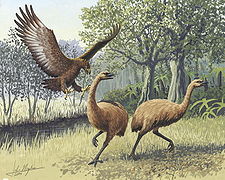
The giant Haasts eagle is shown attacking New Zealand moas.
September 16, 2009

The giant Haasts eagle is shown attacking New Zealand moas.
In 2007, when Tony Lucas shared his list of “Lesser Known Cryptids of New Zealand,” one he mentioned was the Pouakai.
Tony wrote on Cryptomundo:
The Maori (or Ma¯ori) folklore tells of the Pouakai, a large bird that often attacked warriors and was quite capable of carrying off children. Could this have been the now extinct Haasts eagle, Harpagornis moorei (shown above), said to be one of the world’s largest living eagle? Female Haast’s eagles weighed 10 to 15 kg (22 to 33 lb), and males weighed 9 to 10 kg (20 to 22 lb). They had a wingspan of roughly 2.6 to 3 m (8 to 10 ft) at most, which was short for a bird of the eagle’s weight (the largest Golden Eagles and Steller’s Sea Eagles may have wings of almost the same width), but aided them when hunting in the dense forests of New Zealand.
I noted that Harpagornis had been shown to be synonymous with Hieraaetus, according to Darren Naish.
Now comes the following story, which has been making the rounds all week, from Auckland, New Zealand: “Haast eagle was ‘ultimate killing machine’” ~
It might not have killer crocs but New Zealand was once home to an even more fearsome creature that could rip apart humans with its claws.
New research has confirmed that a giant man-eating bird long spoken of in legends actually existed.
And the Haast eagle was even bigger and more deadly than first thought, fulfilling the same role as the killer lions of Africa.
Each creature had a wingspan of three metres and weighed almost 20kg, making more than twice the size of the largest eagle that survives today.
“It was certainly capable of swooping down and taking a child,” Paul Scofield, of Canterbury University in New Zealand, said.
Its talons were as big as a tiger’s claws, making it the ultimate “killing machine”, he said.
“They had the ability to not only strike with their talons but to close the talons and put them through quite solid objects such as a pelvis.”
Until now, the eagle has been nothing more than a legendary bird called a Te Hokioi by Maori.
The first known account of this mystical bird was given to 19th Century New Zealand governor Sir George Grey, who described it as a huge black-and-white predator with a red crest and yellow-green tinged wingtips.
Pictures of the giant creature could be found all through early Maori rock drawings but they were presumed imaginary.
Remains of the Haast eagle had been collected in the 1870s but early examinations found it was a scavenger like a vulture.
However, new tests of the skeletons using modern technology, including CAT scans, have revealed the eagle and legendary Te Hokioi are one and the same.
The research, published in The Journal of Vertebrate Paleontology, concluded the bird is the Kiwi equivalent of the great African lion.
It survived on a diet of moa, another giant but flightless bird and became extinct just 500 years ago, after humans killed off its food source.
=========
Support the new, public, physical location of the International Cryptozoology Museum in downtown Portland, Maine. Help us meet the feeding requirements of all the maneating birds around, and other new expenses for this great adventure.
Please click on the button below (not the one up top) to take you to PayPal to send in your donation.
If you wish to send in your donation via the mails, by way of an international money order or, for the USA, via a check or money order, please use this snail mail address:
Loren Coleman
International Cryptozoology Museum
PO Box 360
Portland, ME 04112
Thank you, and come visit the museum at 661 Congress Street, Portland, Maine 04101, beginning November 1, 2009!!
About Loren Coleman
Loren Coleman is one of the world’s leading cryptozoologists, some say “the” leading living cryptozoologist. Certainly, he is acknowledged as the current living American researcher and writer who has most popularized cryptozoology in the late 20th and early 21st centuries.
Starting his fieldwork and investigations in 1960, after traveling and trekking extensively in pursuit of cryptozoological mysteries, Coleman began writing to share his experiences in 1969. An honorary member of Ivan T. Sanderson’s Society for the Investigation of the Unexplained in the 1970s, Coleman has been bestowed with similar honorary memberships of the North Idaho College Cryptozoology Club in 1983, and in subsequent years, that of the British Columbia Scientific Cryptozoology Club, CryptoSafari International, and other international organizations. He was also a Life Member and Benefactor of the International Society of Cryptozoology (now-defunct).
Loren Coleman’s daily blog, as a member of the Cryptomundo Team, served as an ongoing avenue of communication for the ever-growing body of cryptozoo news from 2005 through 2013. He returned as an infrequent contributor beginning Halloween week of 2015.
Coleman is the founder in 2003, and current director of the International Cryptozoology Museum in Portland, Maine.
Filed under Avian Mysteries, Breaking News, Cryptotourism, CryptoZoo News, Extinct, Fossil Finds, Thunderbirds, Winged Weirdies